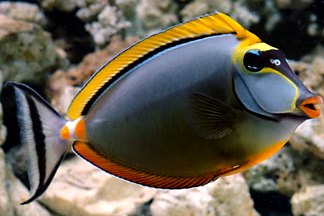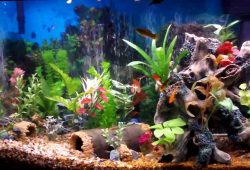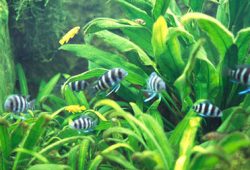Naso Tangs for the Tropical Saltwater Aquarium
In the following article you will find some basic information on Naso Tangs for the Tropical Saltwater Aquarium. This magnificent fish, which can grow to eighteen inches, needs plenty of swimming room and an aquarium that is at least five feet long (and preferably longer). The naso tang is a beautiful and powerful animal best kept by the aquarist with some solid experience under his or her belt. With the proper husbandry, the naso tang is undoubtedly one of the most stunning of all marine aquarium fishes and can do quite well in the home aquarium.

Identification
From the genus Naso, the naso tang can be readily differentiated from other tangs by counting the number of anal spines and pelvic rays they possess (naso tangs have two anal spines and three soft pelvic rays). The fishes in this genus are known commonly as unicornfish, and while Naso lituratus is the most common in the hobby, there are others that are equally attractive and appropriate for the home tropical marine aquarium. Naso elegans, commonly called the blonde naso tang or the orange-spine unicornfish, is closely related but hails from the Red Sea and Indian Ocean.
Generally peaceful, plan to keep only one naso tang per aquarium, as they can show aggression with conspecifics in all but the largest aquaria.
Reef Compatibility
Many aquarists consider the naso tang to be reef compatible, but some individual fish have been known to pick at stony corals with larger polyp sizes. Keep in mind that the naso tang is a large, powerful fish, and, as such, the collateral damage to expensive coral specimens simply as a result of swimming and moving about in the aquarium can be significant. In addition, do watch out for the spines on the naso tang’s caudal peduncles—they can easily slice to the bone.
Diet
Perhaps the biggest hurdle to overcome when keeping a naso tang (assuming it has a sufficiently large aquarium, brisk circulation and appropriate filtration) is feeding. Smaller naso tangs may well need to be weaned onto a captive diet by first offering live foods such as live gut-loaded adult brine shrimp. Naso tangs are primarily herbivores, and so it is a good idea to offer live marine algae to a new specimen’s diet from the start.
Gradually begin mixing commercially prepared freeze-dried, flake or frozen food to the live food until the naso tang is weaned onto a captive diet. Once acclimated, the naso tang is an eager eater and will readily consume most any food you add to the tank. Be sure to keep the diet balanced by supplementing commercial food preparations with meaty bits of raw table seafood like shrimp, clams and mussels.



